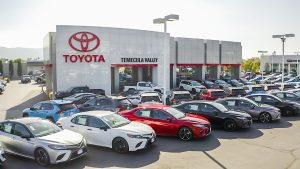With new vehicle prices rising for a multitude of reasons, the average monthly payment for a new vehicle is fast approaching $800 a month. More importantly, more buyers than ever are paying over $1K a month for a vehicle.
New vehicle prices keep rising, tariffs being the latest catalyst to push the average price of a new vehicle closer to $50,000. Consumers continue to look for ways to get the vehicles they want for the monthly payment they can afford.
Despite longer loan terms — 84 months in some instances, a record 20% of all new vehicle buyers are paying at least $1,000 a month for a new vehicle. According to Edmunds.com, 19.3% of all new car buyers in the second quarter added a comma to their monthly vehicle payments.
Multiple reasons
“It would be easy to assume that tariffs are already reshaping the market, but the reality is that the record-breaking trends we saw in the second quarter are reflective of more consumers opting for maxed-out term lengths despite vehicle prices remaining steady,” said Ivan Drury, Edmunds’ director of insights.
However, the rising payments are part of an ongoing trend that has seen consumers shift from seeing how much a vehicle costs to what it will cost them per month. As a result, longer term loans are coming into vogue.
There was a time when a 48-month term was the norm with 60 months, or five years, seen as a way to help people with less than ideal credit get into a vehicle. However, with leasing programs helping to reduce the monthly payment, demand for longer term loans has skyrocketed.
Stretch it out
Edmunds analysts report that 84-month+ loans set a new record in Q2 2025, accounting for 22.4% of new-vehicle financing — up from 20.4% in Q1 2025 and 17.6% a year ago. Compounding the issue is the fact that buyers are putting down less money to buy vehicles, thus financing more — driving the demand for the longer loan terms.
“It’s clear that buyers are pulling the few levers they can control to manage affordability, whether that’s by taking on longer loans, financing more, or putting less money down — even if some of those decisions increase their total costs,” Drury added.
Creative financing has always been around — and at both ends. For buyers with outstanding credit, the 0% loan helped to buoy the industry during sluggish sales periods. However, demand for vehicles is strong and zero percent financing is going the way of the dodo, accounting for less than 1% of all new vehicle loans last quarter. The average interest rate for a new vehicle loan last quarter was 7.2%, up slightly from Q1’s 7.1%.
More Consumer News
- Trump Tariffs Likely to Drive Budget Buyers Out of New Vehicle Market
- Car Prices to Rise Average $2,000 as Tariffs Take Hold
- June Car Sales Stall Under Weight of Tariffs
Worst to come
One of the reasons automakers have been decrying the Trump administration’s tariffs isn’t just the fact that it will cut into their profit margins. It will make it tougher for many who want to buy a vehicle to do so. The current trends are before the levies have really taken hold on the marketplace.
“Consumers are continuously stretching to afford new vehicles in this market, and while tariffs haven’t directly driven these Q2 numbers, they’re certainly not going to make things any easier for shoppers moving forward.”
With rising prices and monthly payments often comes rising delinquency rates. This ugly cycle can kill a market enjoying strong demand. It can also make it difficult for buyers to trade in a vehicle in a few years.
“While extended loan terms may make a monthly payment more palatable, consumers need to keep in mind the risks associated with a loan extended that far into the future, including increased costs for upkeep down the line and the risk of being underwater on the loan if the car is traded in before it’s paid off,” said Joseph Yoon, Edmunds’ consumer insights analyst.
“If payments on a more standard 60- or 72-month loan don’t fit your budget, you might consider leasing. While you won’t be building equity in your vehicle the way you do with a purchase, leases afford time to get your finances in better shape with lower monthly payments in the meantime.”






0 Comments